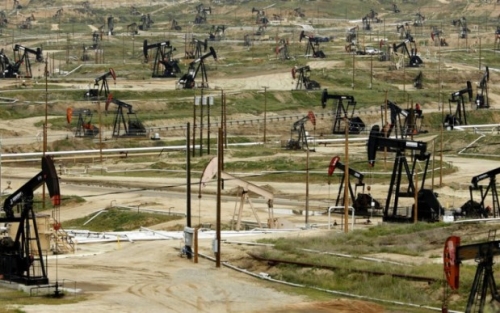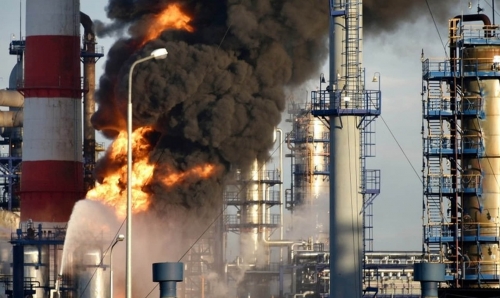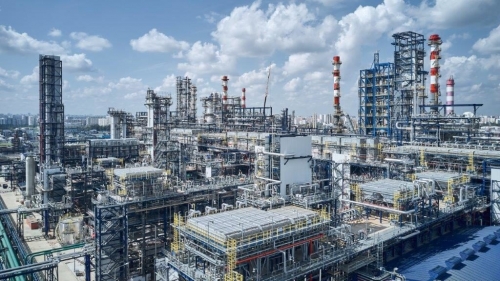Oil prices saw a noticeable increase for most of the week before a slight dip Thursday, amid US tariffs negotiations with key partners and potential sanctions on Russia.
BKR Rig Count | The total active drilling rigs in the United States decreased by 2 last week, to 540. Oil rigs dropped by 5 to 410, and gas rigs increased by 2 to 124. Rig count in the Permian Basin dropped by 1 to 259 | Aug 1 | BKR NAM Rig Count
US Crude Inventories, excluding those in the Strategic Petroleum Reserve (SPR), increased by 7.7 MMbbl to 426.7 MMbbl (about 6% below the 5y average for this time of year). On the products side, gasoline decreased by 2.7 MMbbl (1% below the 5y average). Distillate fuels increased by 3.6 MMbbl (16% below the 5y average). Total commercial petroleum inventories increased by 7.1 MMbbl | Jul 25 | EIA Weekly Report
OPEC+ has agreed to raise oil production by 547,000 b/d for September, the latest in a series of accelerated output hikes to regain market share, as concerns mount over potential supply disruptions linked to Russia. The move marks a full and early reversal of OPEC+'s largest tranche of output cuts plus a separate increase in output for the United Arab Emirates amounting to about 2.5 million bpd, or about 2.4% of world demand | Aug 3 | Reuters
The US and European Union have reached an historic tariff agreement. The agreement imposes a uniform 15% U.S. import tariff on most goods from the EU—significantly lower than the 30% rate Trump had threatened to implement. In return, the EU has committed to vast investment in the US energy and defense sector, with $250 billion spent annually on U.S. energy imports—covering liquefied natural gas, crude oil, and potentially nuclear fuels, while agreeing to open certain markets to American exports at zero tariffs. The announcement sent oil prices higher at the beginning of the week. Market optimism was buoyed by the expectation of increased U.S. energy exports to Europe | Jul 27 | OilPrice
India told its oil refiners to come up with plans for buying non-Russian crude. The request came after a social-media post by US President Donald Trump announced that India would face “penalties” because of ongoing purchases of Russian energy that helped to fund the war in Ukraine. JP Morgan analysts wrote that it could affect 2.3 million bpd of Russian oil exports that would have to be diverted to China and other buyers if New Delhi were to halt buying | Jul 31 | Bloomberg, CNBC
Iran to lead conventional refinery capacity growth in the Middle East by 2030. This growth is underpinned by large-scale projects, particularly in Iran and Iraq. Both countries are leveraging their vast crude oil reserves to expand refining infrastructure, aiming to meet rising domestic demand, reduce imports of refined products, and strengthen export capabilities. A total of 15 new-build and expansion projects are expected to come online in Iran by 2030. New-build projects lead the count and are also set to account for over 90% of the country’s total capacity additions by 2030. Iraq is expected to follow Iran in terms of refinery capacity additions, with nearly 1.9 million barrels per day of capacity expected to be added by 2030 | Jul 30 | GlobalData
The US Environmental Protection Agency unveiled a proposal to abolish the landmark determination that planet-warming gases endanger public health and welfare. If finalized, the measure would lay the foundation to unwind a host of regulations limiting emissions from power plants, oil wells and automobiles. Rolling back the 2009 endangerment finding would be among the most far-reaching steps yet by President Donald Trump’s administration to gut US capacity to fight climate change. The finding forms the bedrock of the government’s authority to impose limits on carbon dioxide, methane and other greenhouse gases | Jul 29 | Bloomberg
Google sees Asia as one of the “most challenging parts of the world” to decarbonize its operations. Some places, like Taiwan for example, are especially tough for the tech giant to secure enough renewable electricity due to a lack of supply, Giorgio Fortunato, Google head of clean energy and power for the Asia Pacific, said. Japan, meanwhile, doesn’t have a lot of space for utility scale solar. “We need a portfolio of advanced clean technology that can complement gaps in generation,” he said, adding that geothermal technology has potential in Asia | Jul 30 | Bloomberg
New Zealand wants to double geothermal energy use by 2040 to aid its transition to renewable electricity and reduce greenhouse gas emissions. The government has begun consultation on a refreshed strategy to tap the South Pacific nation’s geothermal potential, Resources Minister Shane Jones said. “Our unique geographic position on the boundary of both the Australian and Pacific tectonic plates, coupled with the Earth’s thin crust along that rift, gives us a significant geological advantage in expanding the use of this abundant natural resource,” Jones said | Jul 29 | Bloomberg
Looking ahead
S&P Global Crude Oil Markets Short Term Outlook: A little too little or a little too much oil? High seasonal demand and strong distillate margins are currently supporting crude oil prices, but a large supply surplus is approaching. S&P global crude-on-crude balance forecasts a fourth-quarter supply surplus of 2 million b/d, up from 850,000 b/d in the third quarter, as seasonal demand weakens and supply increases. Geopolitical tensions pose ongoing price risks, with the EU tightening restrictions on Russian oil trade and President Donald Trump threatening sanctions, signaling a stalled US-Russia relationship. Despite severe damage, Iran has not ended its nuclear program. S&P price outlook predicts a decline of over $10/b in Dated Brent prices by the year end, though upside risks remain. Saudi Arabia’s June production level of 9.75 million b/d, up 570,000 b/d from May, indicates a readiness to offset potential geopolitical supply disruptions. This marks Saudi Arabia’s largest month-to-month increase since 2020, aimed at boosting inventories, including those outside the country. This move appears to support President Trump’s goal of curbing rising oil prices amid geopolitical uncertainty. OPEC+ production targets will rise again in August. 3. Strong distillate margins provide temporary protection against a sharp drop in crude oil prices, driven more by supply issues than demand growth. In the US, lower refinery diesel production and changes to biofuels incentives have reduced supply, with distillate inventories at a 20-year low as winter approaches. European refinery production is also down from last year, and the EU’s impending ban on products made with Russian crude will complicate trade. First-quarter 2025 year-over-year world oil demand growth was strong at 1.4 million b/d — with more than half of that growth coming from North America. However, US gasoline demand — accounting for about 10% of total global refined product consumption — has recently fallen below year-earlier levels. Despite newly announced trade deals, US import tariffs are still far higher than they were at the beginning of the year. Chinese demand growth remains subdued. To be sure, demand growth elsewhere in non-OECD Asia, the Middle East and Africa is relatively strong, but overall world growth remains weak. S&P estimate for global oil (total liquids) demand growth for full-year 2025 is 635,000 b/d, down from 866,000 b/d. The biggest factor behind the downward revision is a cut in S&P estimate of NGLs demand. Total world oil demand growth for 2026 is unchanged. June 2025 production for Saudi Arabia was raised to 9.75 million b/d, an upward revision of 380,000 b/d. S&P price outlook is unchanged, except for the second half of 2026, which was lowered by a little over $4/b, on average, because of oil supply surpluses | Jul 30 | S&P
OPEC+ Long Game for Oil Market Share Strengthens as Rivals Slow | OPEC+ has taken a financial hit from its dramatic move to recoup oil market share, but it could pay off in the long term. Wood Mackenzie estimates that growth in non-OPEC supply — led by countries like Brazil, Canada and Guyana — will shrink more than 80% between this year and 2027, when it will almost grind to a halt. Rystad Energy has slashed its outlook in recent months. Saudi Arabia’s surprise decision to steer the OPEC into opening the taps four months ago brought lower prices, depleting state revenues and widening budget deficits — even if that immediate pain has eased in recent months. OPEC+ delegates cited a range of motives for the strategy shift, including Riyadh’s desire to reclaim market share ceded to competitors like US shale drillers. The forecasters’ latest outlook suggest the producers may succeed — if they stay the course. The group next holds a supply meeting on Sunday. “For OPEC+, the light at the end of the tunnel is 2027, when non-OPEC or non-OPEC+ growth slows down very rapidly,” said Jorge Leon, an analyst at Rystad who previously worked at the OPEC secretariat. The slowdown in non-OPEC supply is driven by declines in North America after 2025, along with maturing oil fields in Mexico, China and Norway, according to Ann-Louise Hittle, vice president for oil markets at Wood Mackenzie. The trajectory for OPEC’s own production over the next few years is uncertain. The IEA predicted in June that demand for the group’s crude will decline from next year through to 2029, although it still has a buffer of spare capacity that it can bring online. It’s also unclear whether the Saudis will have the stamina to endure the price slump their gambit may unleash. Oil traders expect crude to sink later this year as extra barrels from OPEC+ swell a surplus created by faltering Chinese demand and brimming US supply. A decade ago, Riyadh launched a price war against US shale companies, only to abandon the attempt 18 months later when the financial fallout proved too onerous | Jul 30 | Bloomberg

%20(1).png)



